|
Nikko Toshogu Shrine
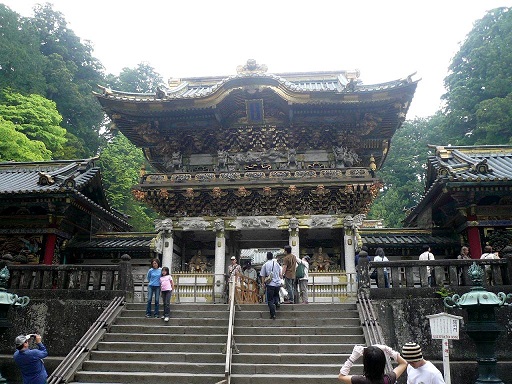
|
One of the most popular historical sites in Japan especially for foreign visitors, is Nikko. Nikko is located approximately 130 kilometers north of Tokyo. Nikko originally was Holy Land of mountain worship. When the first "Shogun", TOKUGAWA Ieyasu
(1543 - 1616)
died, he was buried in Nikkko according to his will and "Toshogu" Shrine was built.
At first, the architecture of shrine buildings were simple but the third "Shogun", TOKUGAWA Iemitsu
(1604 - 1651)
started to rebuild very gorgeous shine buildings in 1634. Now, eight buildings are designated as national treasures of Japan and thirty-four buildings are designated as important properties of Japan.
Nikko Toshogu Shrine was designated as a world heritage in 1999.
After visiting Rinnoji Temple, you will see a big Torii-Gate at the entrance of Nikko Toshogu Shrine. Huge Japanese cedar trees surround the Torii Gate.
It was donated by KURODA Nagamasa
(1568 - 1623)
in 1618.
KURODA Nagamasa was the lord of Fukuoka Domain. The height of the Torii gate is 9 meters.
Near the Torii Gate, the temporary Main shrine Building is located. As the main Shrine buildings of Nikko Toshogu Shrine had been often under repaire, the temporary main shrine building was located at all times. The temporary main shrine building was built in 1639 and the original building remains. It is designated as important property of Japan.
After passing through the Torii Gate, you will see the Five-Storied Pagoda. The Pagoda was built in 1650 by SAKAI Tadakatsu
(1587 - 1662)
, the lord of Obama Domain in the current Fukui Prefecture. It seems every Land Lord made great efforts to build Nikko Toshogu Shrine. Unfortunately, the original Pagoda was damaged in 1815. The current Pagoda was rebuilt eight years after that.
Next, you will go through the "Omote-Mon" Gate. A pair of guardian Deva Kings, "Nio", Statues are located at the gate.
Behind the "Nio" Gate, San-Jinko" Buildings are located.
These are storehouses, where holy treasures used for official events are stored.
|
|
Near the "San-Jinko" buildings, you will see a stable of a scared horse. On the wall of the stable, there are statues of three wise monkeys.
These statues of wise monkeys are well known for "See no evil, Hear no evil, and Speak no evil".
The pronunciation of "No Evil" in Japanese is the same as "Monkey". The reason for the monkey statue seems because of the pronunciation. Also it is said that monkeys are guardian gods for horses. This is another reason for it.
On the way to the main shrine building from the stable, you will go through a bronze Torii-Gate.
Then, you will see the "Rinzo" Hall on your left. "Rinzo" Hall was built in 1636 and is designated as an important property of Japan.
|
"Rinzo" Hall
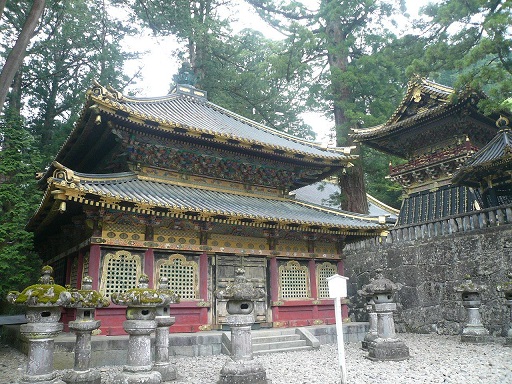
|
"Honchi-Do" Hall
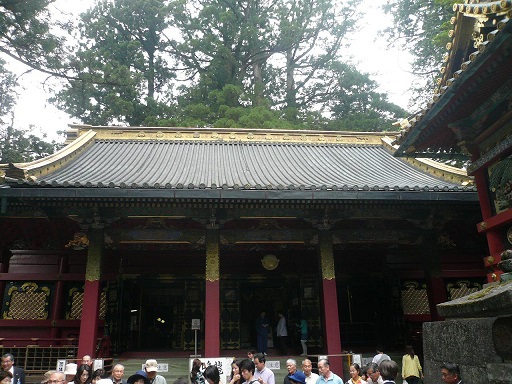
|
|
Behind the "Rinzo" Hall, "Honchi-Do", another name is "Yakushi-Do", is located. A dragon is painted on the ceiling of the "Honchi-Do" Hall. If you stand below the dragon print and clap your hands, the clapping sound resonates inside the hall. "Honchi-Do" Hall is also designated as an important property of Japan.
On your right side from the "Honchi-Do" Hall, there are stone steps and the "Yomei-Mon" can be seen at the top of the stone sites.
The "Yomei-Mon" Gate is a very gorgeous gate with very precise decorations. This is the symbol of Nikko Toshogu Shrine. It was built in 1636 and designated as a national property of Japan.
As the gate is very gorgeous and beautiful, people would look at the gate while forgetting time has passed until sunset. Another name of the gate is "Higurashi-Mon". It means the gate of sunset.
|
Yomei-Mon Gate
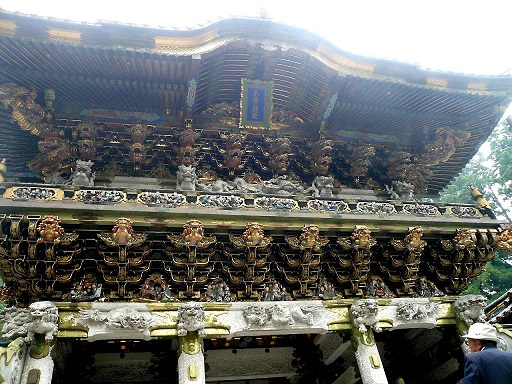
|
Corridor
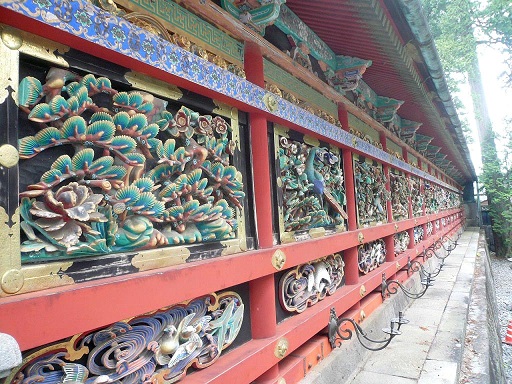
|
|
The corridor is located on both sides of the "Yomei-Mon" Gate to protect the main area of Nikko Toshogu Shrine. The corridor is also precisely decorated and is designated as a national treasure of Japan.
After passing through the "Yomei-Mon" Gate, you will see the "Kara-Mon" Gate in front of you.
The decoration of "Kara-Mon" Gate is covered with white chalk. The gate is also spectacular and very beautiful.
In the Edo Age
(1603 - 1868)
,
only the novelist people who were allowed to see a "Shogun" were able to go through the gate. The "Kara-Mon" Gate was built is 1636 and is designated as a national treasure of Japan.
You will walk to the right after passing the "Kara-Mon" Gate.
On the corridor, there is a statue of a cat. The cat is called the "Sleeping Cat. It is said that the statue of the cat was carved by HIDARI Jingoro
(1594? - 1651?)
, who was a well-known engraver. The statue is designated as a treasure of Japan.
You will find the "Sakashita-Mon" Gate to the east of "Kara-Mon" Gate. The "Sakashita-Mon" Gate is the exit of the main area of the Nikko Toshogu Shrine and also the entrance to the "Okusha" Shrine, the rear shrine of the Nikko Toshogu Shrine. In the "Okusha" Shrine, the grave of TOKUGAWA Ieyasu
(1543 - 1616)
.
|
"Sakasita-Mon" Gate
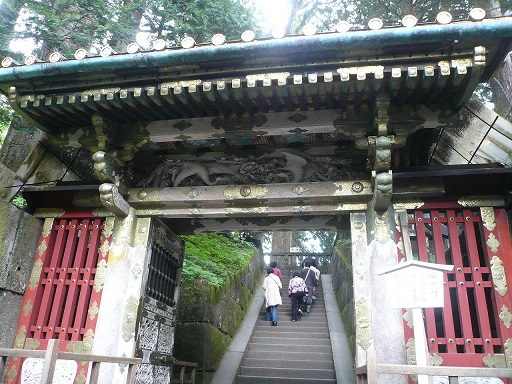
|
|
"Okusha" Stone Fence
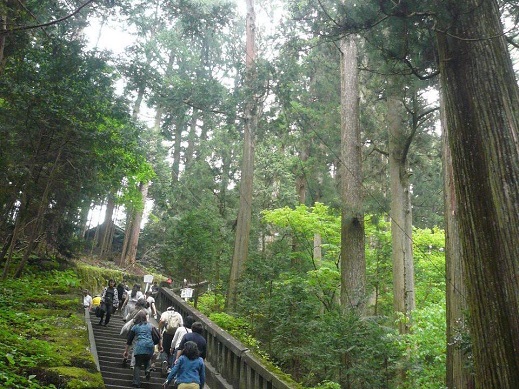
|
|
After passing through the "Sakashita-Mon" Gate, stone steps continue to the "Okusha" Shrine. Huge Japanese cedar trees surround the stone steps.
Finally, you will arrive at the "Okusha" Shrine of Nikko Toshogu Shrine.
Behind the "Okusha" Shrine building, there is the "Inuki-Mon" Gate. This gate is the final gate to the grave of TOKUGAWA Ieyasu
(1543 - 1616)
.
During the
Edo Age
(1603 - 1868)
, it supposed that even any "Shoguns" could not go through the gate to the grave of TOKUGAWA Ieyasu
(1543 - 1616)
,
because this was the most important and the most sacred place. But, now pavement is well prepared to the grave of TOKUGAWA Ieyasu
(1543 - 1616)
.
The bronze pagoda shown in the above picture is the grave of TOKUGAWA Ieyasu
(1543 - 1616)
.
TOKUGAWA Ieyasu
(1543 - 1616)
was born at
Okazaki Castle
and he established TOKUGAWA Family's government, "Edo Shogunate", in 1603 to end the age of civil war.
Because of his triumphs, he was worshipped as a god and Toshogu Shrine was built.
|
|
|
How to get there
To go to Nikko, you will take a Limited Express "Kegon" on Tobu Line from Asakusa Station. "Kegons" run at once or twice a hour. Or Take a Tohoku Shinkansen to Utsunomiya and change to the JR Nikko Line to JR Nikko Station.
Both from JR Nikko and Tobu Nikko Station, take a bus to "Shinkyo". Then, walk to Nikko Toshogu Shrine. It takes approximately 10 minutes from the Shinkyo Bus stop to Nikko Toshogu Shrine.
Other Historical Sites near by:
Nikko Futaarasan Shrine
Rinnoji Temple
Taiyuin Temple
Ruins of Ashio Copper Mine
|
|

 Home Page in Japanese: "Shane's HomePage"
Home Page in Japanese: "Shane's HomePage"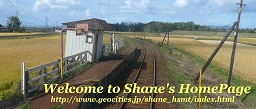

 Home Page in Japanese: "Shane's HomePage"
Home Page in Japanese: "Shane's HomePage"